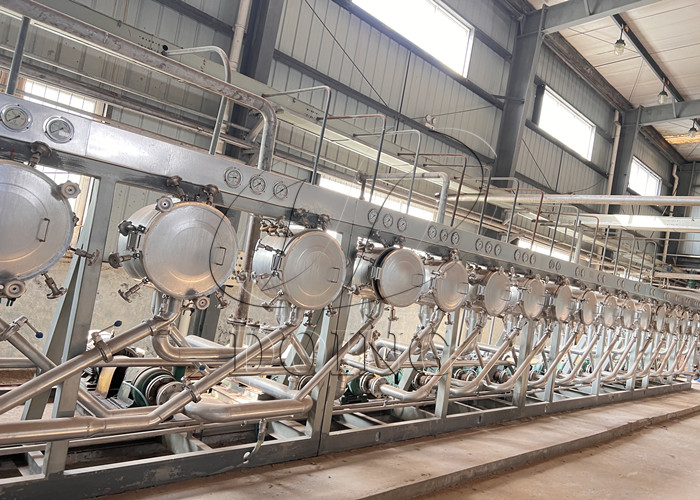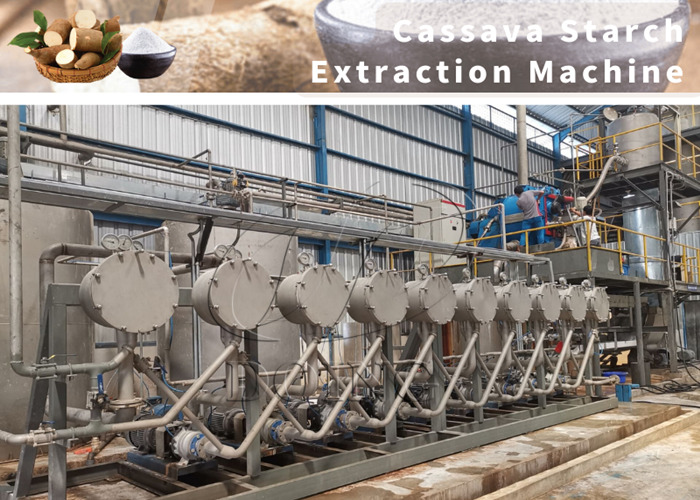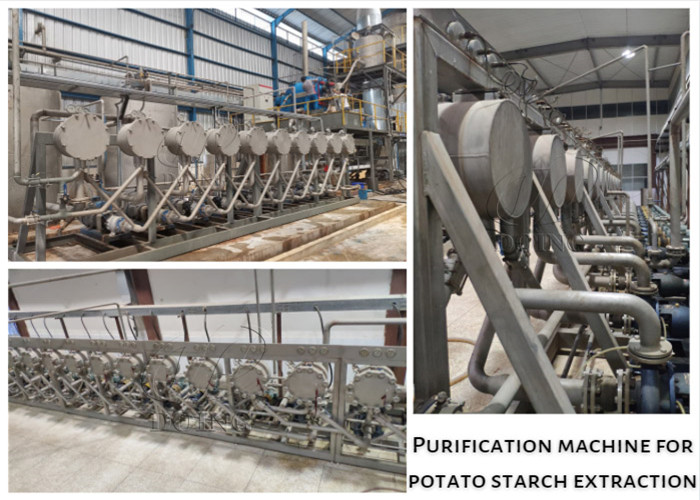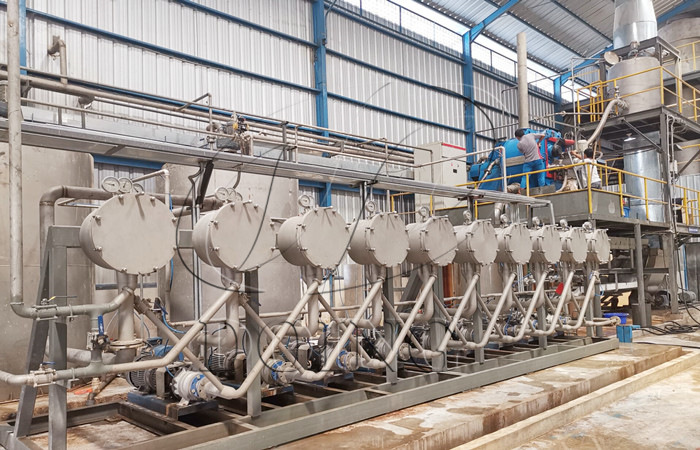 Tel/WhatsApp
Tel/WhatsApp
Tapioca starch hydro-cyclone station configuration: which stage should I choose?
The hydro-cyclone station is an essential equipment in tapioca starch processing. However, choosing the right hydro-cyclone station stage often confuses tapioca starch processors. Are you also struggling with choosing the right hydro-cyclone station stage? In this article, Henan Jinrui, a professional manufacturer of tapioca starch processing equipment, will provide a detailed introduction to hydro-cyclone station configuration and help you analyze which stage of hydro-cyclone station configuration is best for your cassava starch business, helping you resolve this dilemma!
The stages of hydro-cyclone station directly impacts the quality and efficiency of the final tapioca starch product. Generally speaking, the 18-stage hydro-cyclone station configuration is most suitable. To determine the optimal hydro-cyclone stage configuration, you first need to understand the functions of each stage in a typical hydro-cyclone station configuration. Below is an introduction to the functions of typical hydro-cyclone stages.
 hydro-cyclone station confugration
hydro-cyclone station confugration
The Introduction for Hydro-cyclone Stations Configuration
A common hydro-cyclone station configuration consists of 18 stages, each with a specific function. Taking Henan Jinrui's hydro-cyclone station as an example, the hydro-cyclone components are divided into three stages based on their intended use: concentration, recovery, and washing. Generally, stages 1-3 involve recovery, stages 4-5 involve concentration, stages 6-7 involve recovery, and stages 8-18 involve simultaneous concentration and washing. During these stages, impurities such as ash, protein, cell fluid, and impure fibers are thoroughly removed from the starch milk, ensuring that the final starch product meets the required purity standards, typically reaching 23 Be. After passing through the 18-stage hydro-cyclone, Henan Jinrui's hydro-cyclone station achieves a purity of 22 Be.
 Tapioca starch extraction equipment
Tapioca starch extraction equipment
Why to Choose 18-Stage Hydro-cyclone Stations Configuration?
Now that you understand the working principles of common hydro-cyclone station configuration, do you know why an 18-stage hydro-cyclone station configuration is the best choice for tapioca starch processing? In fact, choosing the stages of hydro-cyclone station configuration requires considering a variety of factors. Below, Henan Jinrui will analyze the raw material properties, starch quality, and cost-effectiveness to help you understand why an 18-stage hydro-cyclone is the best choice.
1. Raw material nature: The hydro-cyclone stage configuration you choose depends largely on the nature of the tapioca starch raw material. If the starch emulsion is high in impurities, more stages are required; generally, an 18-stage hydro-cyclone station configuration is sufficient. These stages effectively separate and remove various impurities, ensuring the purity of the cassava starch is intact. If the starch emulsion is relatively low in impurities, a fewer-stage configuration may be sufficient. Henan Jinrui can recommend the appropriate hydro-cyclone station stage configuration based on your needs and the intended use of the finished product. If you don’t know how to choose, you can contact Henan Jinrui professional and experienced sales managers will answer your questions.
 Cassava starch processing equipment
Cassava starch processing equipment
2. Starch purity requirement: Another important factor influencing the choice of hydro-cyclone stage configuration is the purity requirements of the final starch product. If the final starch is destined for high-end applications with extremely high purity requirements, such as the food or pharmaceutical industries, more stages will be required, especially the later refining stages. These stages can meticulously remove even trace amounts of impurities, ensuring that the starch meets the strict quality standards of these industries. Conversely, if the starch is used in applications with lower purity requirements, such as certain industrial fields, fewer stages may be acceptable to balance product quality and production efficiency.
3. Cost-effectiveness: Furthermore, when selecting the stages of hydro-cyclone station configuration, production efficiency and cost must be considered. While using more stages will undoubtedly improve starch purity and yield, it will also increase energy consumption and equipment investment costs. Therefore, in actual cassava starch production, a balance must be struck between product quality and cost. According to most cassava starch processors, the 18-stage hydro-cyclone station configuration is the optimal choice!
 Henan Jinrui's hydro-cyclone station
Henan Jinrui's hydro-cyclone station
In conclusion, the choice of stage in the tapioca starch hydro-cyclone station configuration is a comprehensive decision based on the nature of the raw materials, the purity requirements of the final product, and production efficiency and cost. Generally speaking, for tapioca starch processing, 18-stage hydro-cyclone station configuration is sufficient. If you have other questions about tapioca starch processing, please contact Henan Jinrui! We have a experienced sales team and engineering team to provide you with professional equipment solutions!
-
 Unlocking Nigeria's Potential: Starting a Lucrative Cassava Starch Business
Unlocking Nigeria's Potential: Starting a Lucrative Cassava Starch Business
-
 5 Must-Know Features Before Buying a Modern Cassava Starch Machine
5 Must-Know Features Before Buying a Modern Cassava Starch Machine
-
 Advantages of Modern Garri Processing Equipment Over Traditional Methods
Advantages of Modern Garri Processing Equipment Over Traditional Methods
-
 How does the manioc flour flash dryer reduce energy consumption?
How does the manioc flour flash dryer reduce energy consumption?
-
 What Kind of Engineering Service Can Henan Jinrui Offer in Garri Processing Project?
What Kind of Engineering Service Can Henan Jinrui Offer in Garri Processing Project?
-
 Tapioca starch hydro-cyclone station configuration: which stage should I choose?
Tapioca starch hydro-cyclone station configuration: which stage should I choose?
-
 A guide to expanding from cassava planting to cassava flour processing in Indonesia
A guide to expanding from cassava planting to cassava flour processing in Indonesia
-
 The Advantages of Fully Automatic Potato Starch Production Lines
The Advantages of Fully Automatic Potato Starch Production Lines
-
 From cassava to fufu flour: key processing steps and quality control points
From cassava to fufu flour: key processing steps and quality control points
-
 Ratio of cassava to starch: How many tons of cassava can extract one-ton starch?
Ratio of cassava to starch: How many tons of cassava can extract one-ton starch?
-
 Garri Processing Equipment: A Deep Dive into Production Costs and Profitability
Garri Processing Equipment: A Deep Dive into Production Costs and Profitability
-
 Doing Factory Ships High-Quality Garri Processing Equipment to Nigeria
Doing Factory Ships High-Quality Garri Processing Equipment to Nigeria
-
 Selling High-Quality Cassava Processing Equipment to Uganda
Selling High-Quality Cassava Processing Equipment to Uganda
-
 Gari processing line successfully shipped to Nigeria
Gari processing line successfully shipped to Nigeria
-
 Cassava starch fine fiber sieve purchased by Indian client
Cassava starch fine fiber sieve purchased by Indian client
CONTACT US
DOING company offers cassava processing machine from single machine to the complete production line. If you want to get more details about cassava processing machine, please contact us:
- Do you want to buy machine?
- Yes, I want to buy machine
- No, I want to learn more in advance.
- What is your raw material?
- Cassava
- Potato
- Sweet potato
- Others
- 2. What is the final product you want to produce?
- Garri
- Cassava flour
- Cassava starch
- Cassava chips
- Attiekie
- Bammy
- Others
- 3.What is your capacity plan?
- Small scale garri machine
- 1ton per day
- 2tons per day
- 3tons per day
- 10tons per day
- 20tons per day
- Others
- 3.What is your capacity plan?
- Small scale
- 5tons per day
- 10tons per day
- 20tons per day
- 50tons per day
- 100tons per day
- Others
- 3.What is your capacity plan?
- Small scale
- 5tons per day
- 10tons per day
- 20tons per day
- 50tons per day
- 100tons per day
- 200tons per day
- 300tons per day
- Others
- 3.What is your capacity plan?
- Small scale
- Middle type
- Large scale
- What is your capacity plan?
- Small scale
- 5tons per day
- 10tons per day
- 20tons per day
- 50tons per day
- 100tons per day
- 200tons per day
- 300tons per day
- Others








